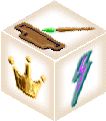How NASA went to the Moon 
Design • Build • Use • Integration | | This is a story of how NASA went to the moon. It is not a commonly understood story and it is not often told. It is a story that the NASA people, themselves, did not know at the time they lived it. Unfortunately, few know it today. | | I first told the story to a group of NASA engineers in 1982 and the they were shocked - shocked because they had never heard it before and shocked because it captured so well what they had actually experienced. The story was my analysis of how they did what seemed, at the time, to be a miracle. We were not involved in the Moon program - I was an interested observer. NASA became a client of ours in the 90s and then in the aeronautics division. However, many of the processes and Models that we use today are formal constructs of what I SAW NASA do in the 60s. My fist telling of the story, and the engineers acceptance of it, was a proof-of-concept step in our process. We developed the ideas further by developing Models and applying them to the design of client DesignShops. This is how we know - even if the memory is lost at NASA - how NASA did it. | | This story, tragically, is one of huge technical success and social failure - going to the Moon was an ill conceived notion brilliantly accomplished by an un-stated organizational process - at the end of which - our Nation kept the rocks and “threw away” the organization that accomplished greatness. | | Vital lessons that could have advanced innumerable other efforts were never documented, formally learned and transferred. Many wrong conclusions were drawn and a Nation turned it’s back on a big piece of the future and continues to live - perhaps at great risk - on a single point of failure. | | NASA, today, is still a great organization full of dedicated people. It has become, however, a creature of national politics and the ultimate bureaucratic model with many of it’s brilliant people hamstrung in a process that absorbs most of their community’s energy. Still capable of great dreams and and great accomplishments, but now an organization largely on the defensive - not on the go. | | There was a period where politics and bureaucracy briefly lost their grip to the magic of an almost impossible challenge - a challenge that drove innovation, released genius and briefly allowed to flash one the most effective organizational efforts in human history. | | | NASA employed a processes architecture made up of three interactive elements: Design Strategy, Performance Specifications and Administrative Method (System Integrator or SPO as it would be called in the Air Force). These three elements were adroitly played to facilitate massive FasTracking, Design/Build/Use and systems integration from a global ValueWeb organization. Yes, a lot was spent - but it was not the money that got it done. It was the largest application of Group Genius in the history of the world. | Performance Specifications | Administrative Method - System Integrator | | “Prove it to me that it will fly!” Design Tradeoffs and keeping a few critical integrating pieces. | | | | Given the complexity of the program and tools that were available at the time, the first lesson is that complex projects can be done well if the right methods are employed and competency establishes the standard that determines what is done. | | | | I do not know of a project or program - even today - that cannot gain huge benefits from studying HOW NASA worked. The technology spin-offs have created billions of technological and business benefit. The organizational lessons are work far more. | | | Matt Taylor
Palo Alto
January 8, 2000 
SolutionBox voice of this document:
INSIGHT • POLICY • PROGRAM |
posted January 8, 2000 revised February 17, 2002
• 20000118.101710.mt • 20010310.459998.mt • 20010328.123489.mt •
• 20010401.542398.mt • 20010217.239865.mt • Copyright© Matt Taylor 2000, 2001, 2002 | |
|